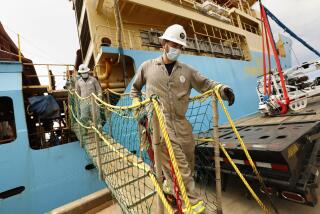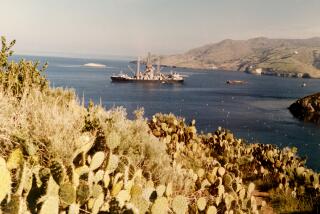Undersea Mapping Aboard Scripps Vessel : Scientists Hope Ship Will Cut U. S.-Soviet Ice
- Share via
A U. S. research ship based in San Diego entered Soviet waters Monday for the first time in a decade, signaling what scientists hope will be a thaw in relations that worsened last year when President Reagan vetoed Soviet participation in a global undersea drilling project.
That move, in April, 1987, kept the Soviets out of the 18-nation Ocean Drilling Program because of Defense Department concern that they would gain access to sensitive high-technology equipment.
On Monday, researchers aboard the Thomas Washington, operated by UC San Diego’s Scripps Institution of Oceanography, began mapping the sea floor and taking rock samples from the Soviet portion of an undersea plateau in the Bering Sea, about 200 miles east of the Kamchatka Peninsula.
Requests Routinely Denied
They include two Soviet geophysicists who are sharing the results of their own research in the area with Western scientists. Until Monday, the U. S. researchers had been able to study only the half of the plateau that lies underneath international or U. S. waters near the Aleutian Islands. Requests to the Soviets to conduct research in their waters had been routinely denied.
The Soviet data is “absolutely” useful for the planned 33-day mission to the northernmost part of a chain of volcanoes that stretches from the Hawaiian Islands, said Peter Lonsdale, a Scripps research associate and chief scientist aboard the ship.
“They brought with them all of . . . the data that their ships have collected, so we’re able to choose sites where they don’t have coverage,” Lonsdale said in a telephone interview from the ship. “And we’ve also learned from their data where the most valuable sites to visit are.”
To assuage Defense Department concerns about security, Lonsdale said, the ship took minor steps such as locking cabinets containing computers and other electronic equipment.
The two Soviet scientists are not being denied access to data or maps, he said.
“It would be quite impossible in any sort of collaborative effort to tell people they couldn’t look at some maps or others,” Lonsdale said. But he added, “We won’t be giving them charts of parts of the U. S. Economic Zone.”
Surprise the First Day
Lonsdale said the first day of work in Soviet waters held a surprise.
“We’re finding that, although this is a very old plateau, about 100 million years . . . there must be some current on the bottom, because over a large area is bare rock,” instead of the sediment cover that would be expected, he said.
Scientists were deploying current meters Monday and beginning to sample sedimented areas, as well as dredging up rocks from the ocean floor, he said.
More than the immediate scientific payoffs, scientists were pleased at the potential implications the mission into Soviet waters may have for joint efforts.
“We hope this marks the beginning of a new era of U.S.-U.S.S.R. cooperation in marine research,” said Edward A. Frieman, director of Scripps.
Already, a second mission to study plankton in Soviet parts of the Bering Sea is being planned for September, said George G. Shor Jr., Scripps associate director for ship operations. Soviet scientists will join that expedition as well.
Hoping for Veto Reversal
Nicklas Pisias, planning committee chairman for the Ocean Drilling Program, for which the United States provides half the funding through the National Science Foundation, said he hopes the two Soviet approvals will lead to a reversal of the U.S. veto of Soviet participation in that project for exploring the Earth’s history by sampling the ocean floor.
“There are scientific problems that can only be addressed by (Soviet) participation or by drilling in the Russian areas,” said Pisias, an Oregon State University oceanographer.
The veto came after lengthy negotiations between the Soviet Union and drilling program officials, and was announced one day before the officials were to leave for Moscow to seal the deal. Angry scientists on the program’s international governing committee passed a resolution asking for reconsideration, to no avail.
William Erb, the State Department’s director of marine sciences, said the Soviets have not brought up Ocean Drilling Program membership during the most recent negotiations.
“My personal view is that any time a relationship improves enough, there are opportunities for trying new things,” Erb said.
He attributed the Soviets’ approval of U. S. research in their waters to improved relations between the two countries.
First Under Treaty Extension
Those include the signing in December in Moscow of an extension of a previously moribund treaty promoting joint ocean research, the U.S.-U.S.S.R. World Oceans Agreement. The Scripps expeditions to Soviet waters are the first two trips approved under that extension, Erb said.
The Ocean Drilling Program, now headquartered at Texas A&M; University after being moved recently from Scripps, conducts research all over the world to answer some fundamental questions about the Earth’s prehistoric past.
Buried in the sediment layers are clues to puzzles ranging from how continents formed to when and why ice ages occurred to why dinosaurs became extinct. But the strength of such a sampling program lies in its comprehensiveness.
If the thaw ends up reopening the drilling program membership issue, it would give the program’s ship, the JOIDES Resolution, access to Soviet waters in the Sea of Japan that have never been studied by non-Soviet scientists, Pisias said.
Plans call for the ship--now taking cores off northwestern Australia--to be working in international or non-Soviet waters in the Sea of Japan by the fall of 1989, he said.
The area in which the Scripps ship is working through Sept. 5 is the northernmost, oldest portion of a chain of undersea mountains, called seamounts, that stretch from the Hawaiian Islands northward.
More to Read
Sign up for Essential California
The most important California stories and recommendations in your inbox every morning.
You may occasionally receive promotional content from the Los Angeles Times.













